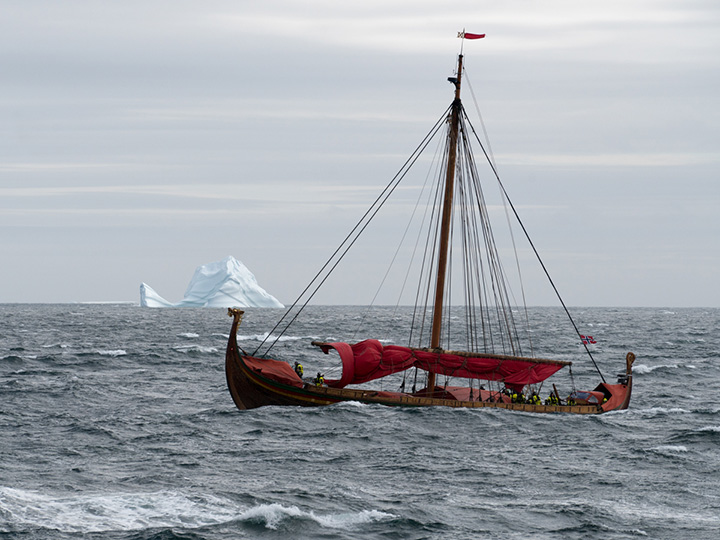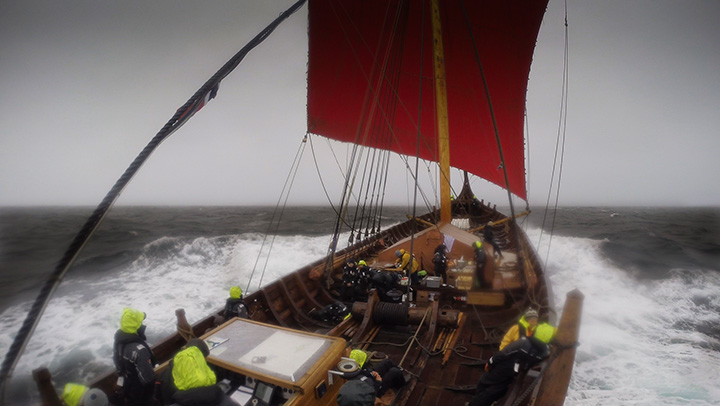Six weeks ago, the Draken Harald Hårfagre and its 32-member crew set sail from Haugesund, Norway, on a journey across the North Atlantic to Canada and the U.S. Yesterday, the world’s largest replica Viking ship docked in St. Anthony, N.L.

That achieved the 35-metre ship’s “first capital goal – the American continent.”
The ship was expected to travel the same route thought to have been taken by the original Vikings nearly 1,000 years ago, from Norway to Iceland, Greenland and Canada, before heading to its final destination in the U.S.
“I’m proud of the crew and the achievements we have made along the way,” Draken captian Björn Ahlander said in a statement. “It has not been easy, we have faced a lot of problems along this voyage but the crew have been in good spirit and worked hard all the way.”
According to the project’s website, dubbed “Expedition America,” the voyage is aimed to “explore and relive one of the most mythological sea voyages – the first transatlantic crossing, and the Viking discovery of the New World more than a thousand years ago.”
The team is composed of men and women from nine countries, including Canada, who were chosen from over 4,000 applicants from all over the world.
Prior to the April 24 launch, Ahlander warned of the dangers the crew could expect during the journey.
“Even though she is a great sailing ship, no one can predict the weather conditions along the way and the crew will face a real challenge,” Ahlander said in a statement. “It’s hard to say which stretch will be the toughest before we’ve set sail, but the waters of Cape Farewell by the coast of Greenland are among the most dangerous waters in the world. It’s extremely windswept and there will probably be a lot of ice.”
Early into the voyage, the Draken ran into some trouble crossing the North Sea between Norway and the Shetland Islands after a shroud broke during the crossing.
A large crane was used to remove the entire mast and rig from the ship as crew members worked to make and tar a new shroud before fitting it back onto the mast.
With no shelter onboard other than a tent, the Draken sailors were expected to face grueling days. The crew will alternate sleep and work shifts with half the crew working four hours at a time while the other half sleeps for four hours.
“It is a challenge to tame the Dragon which makes reliable seamanship extremely important for the expedition,” Ahlander explained. “The work onboard is heavy, wet and cold, therefore it demands a great physical and mental condition. There will be no privacy for the crew, they will be exposed to rain and cold weather with only short breaks to sleep.”
Expedition America marked the beginning of the journey with a traditional Dragon’s Head Ceremony, where the ship’s mythological head is mounted on the stem of the boat.
“The dragon’s head is traditionally not mounted until departure for longer journeys and its purpose is to protect the ship and the crew from sea monsters, bad weather, evil creatures and unforeseen raids,” the project explained on its website.
The Draken measures 35 metres from stem to stern, and its hull is made of oak, a Douglas fir mast and hemp rigging. The ship’s mast reaches 24 metres in height and is sailed with a 260 square-metre silk sail.
“It all started with a daydream, to build a large, seaworthy Viking ship, just like the ones spoken of in the Norse Sagas,” said project curator and owner Sigurd Aase in a statement. “Draken Harald Hårfagre is now a true story, having sailed the challenging voyage across the North Atlantic Ocean.
“This is a dream coming true.” Aase said.
The Viking ship is scheduled to make stops in St. Antony, N.L., Quebec City and Toronto. However, the dates are approximate, based on travel and weather conditions.
Here’s the approximate route and schedule:
April 24 – Haugesund, Norway
May 3 – Reykjavik, Iceland
May 16 – Quqortoq, Greenland
June 1 – St Antony, N.L.*
June 15 – Quebec City, Que.*
July 1-3 – Toronto, Ont.*
July 8 – Fairport Harbor, Ohio, U.S.*
July 14 – Bay City, Mich., U.S.*
July 27 – Chicago, Ill., U.S.*
Aug. 5 – Green Bay, Wisc., U.S.*
Aug. 18 – Duluth, Minn., U.S.*
Sept. (TBD) – Oswego, NY Canals, N.Y., U.S.*
Sept. 15 – New York City, New York, U.S.*
Oct (TBD). – Mystic Seaport, Connecticut, U.S.*
*Approximate dates.
- Life in the forest: How Stanley Park’s longest resident survived a changing landscape
- ‘Love at first sight’: Snow leopard at Toronto Zoo pregnant for 1st time
- Buzz kill? Gen Z less interested in coffee than older Canadians, survey shows
- Carbon rebate labelling in bank deposits fuelling confusion, minister says








Comments